Motivation and Performance Management: A Detailed Analysis
VerifiedAdded on 2024/01/17
|5
|901
|370
Essay
AI Summary
This essay examines the crucial role of job satisfaction and organizational commitment in effective performance management, highlighting their impact on workplace relationships and employee attitudes. It emphasizes that while both contribute to organizational success, job satisfaction is more strongly linked to performance, particularly exemplified by Google's employee-focused strategy. The essay details Google's approach to employee motivation through various perks, high salaries, and a conducive work environment, drawing on Maslow and Herzberg's theories. It also discusses Google's use of performance management principles, such as open office designs and communication channels, to foster collaboration and maintain workplace ethics, ultimately enhancing productivity and innovation. The company's success in attracting job applicants underscores the effectiveness of its integrated motivational and performance management strategies.
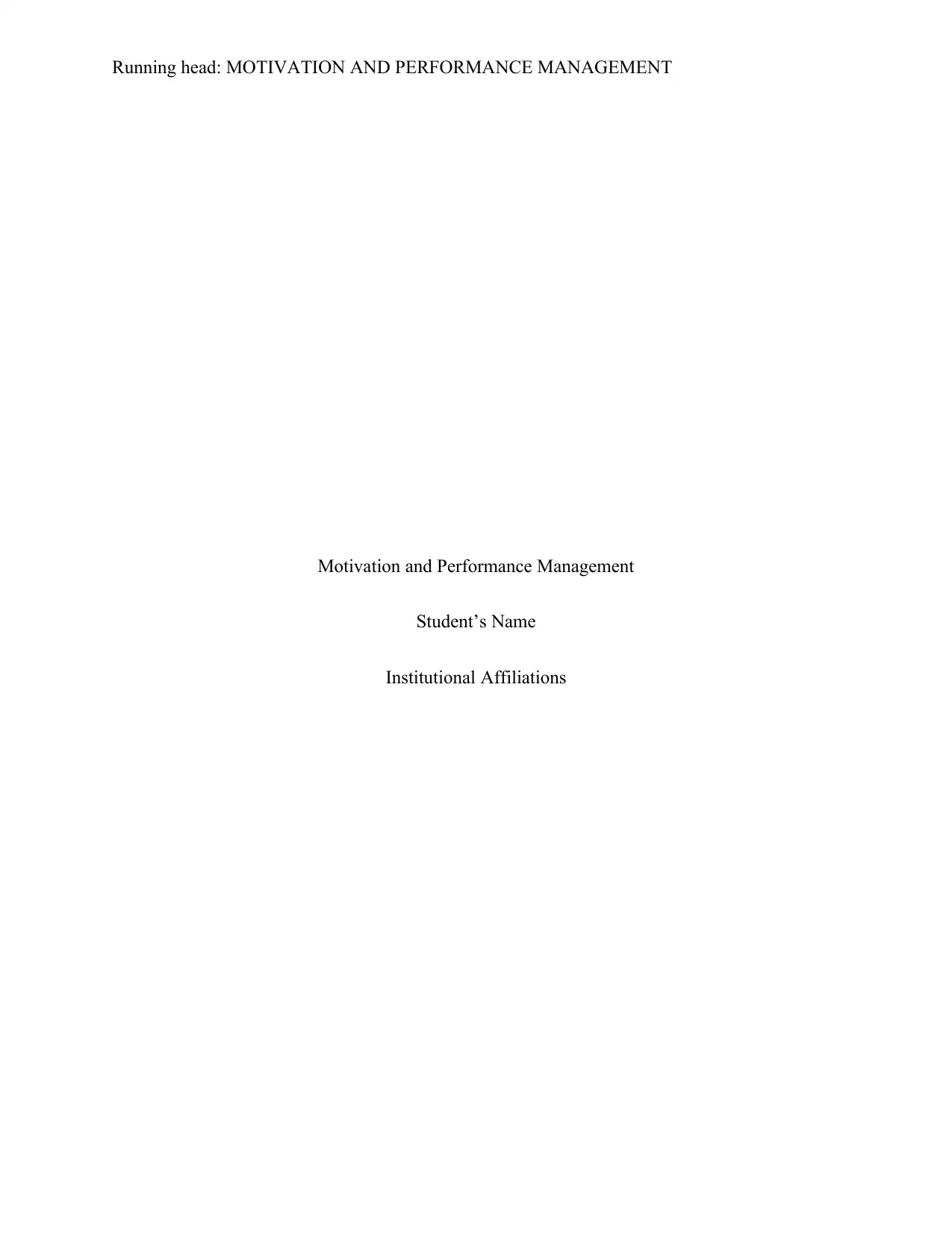
Running head: MOTIVATION AND PERFORMANCE MANAGEMENT
Motivation and Performance Management
Student’s Name
Institutional Affiliations
Motivation and Performance Management
Student’s Name
Institutional Affiliations
Paraphrase This Document
Need a fresh take? Get an instant paraphrase of this document with our AI Paraphraser
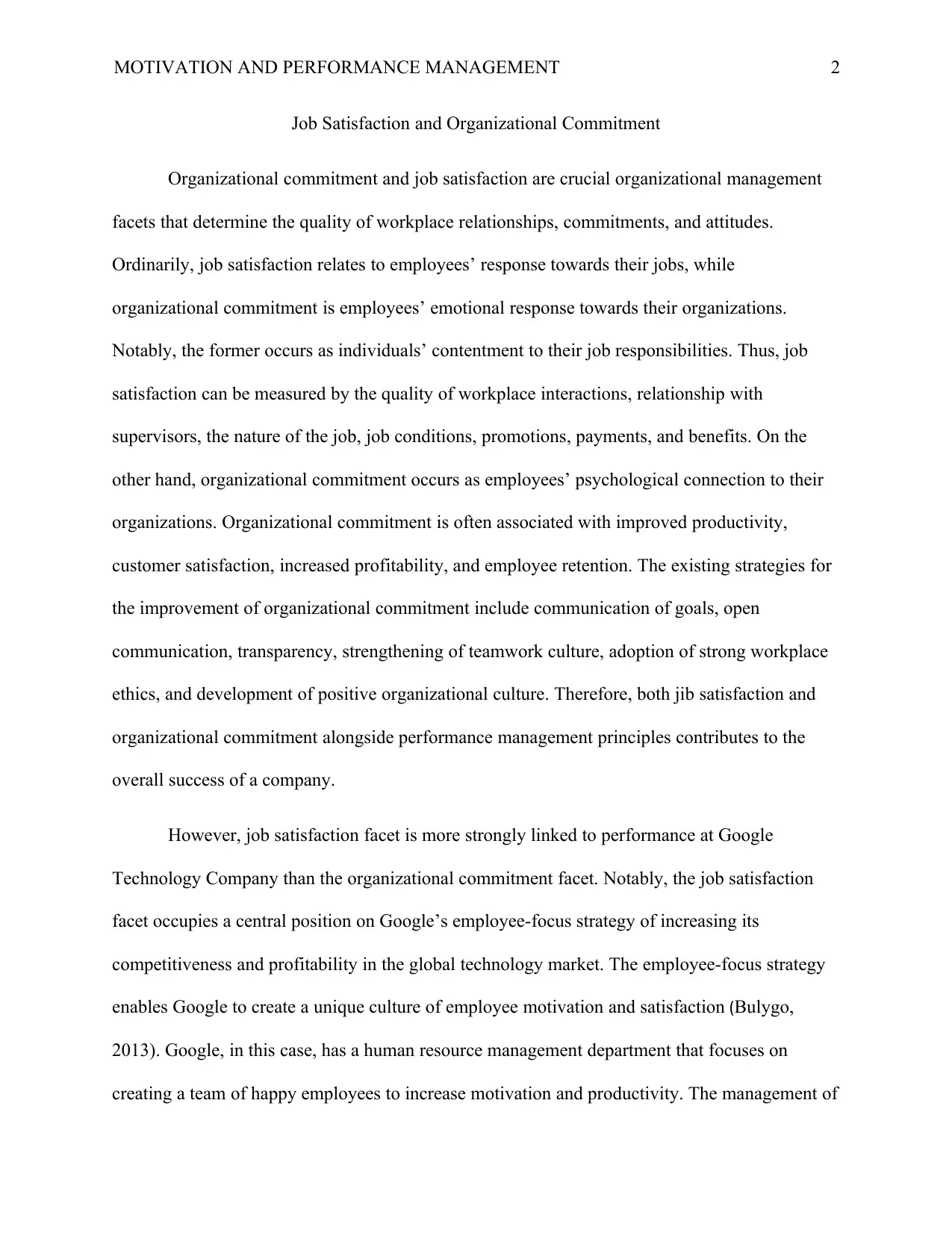
MOTIVATION AND PERFORMANCE MANAGEMENT 2
Job Satisfaction and Organizational Commitment
Organizational commitment and job satisfaction are crucial organizational management
facets that determine the quality of workplace relationships, commitments, and attitudes.
Ordinarily, job satisfaction relates to employees’ response towards their jobs, while
organizational commitment is employees’ emotional response towards their organizations.
Notably, the former occurs as individuals’ contentment to their job responsibilities. Thus, job
satisfaction can be measured by the quality of workplace interactions, relationship with
supervisors, the nature of the job, job conditions, promotions, payments, and benefits. On the
other hand, organizational commitment occurs as employees’ psychological connection to their
organizations. Organizational commitment is often associated with improved productivity,
customer satisfaction, increased profitability, and employee retention. The existing strategies for
the improvement of organizational commitment include communication of goals, open
communication, transparency, strengthening of teamwork culture, adoption of strong workplace
ethics, and development of positive organizational culture. Therefore, both jib satisfaction and
organizational commitment alongside performance management principles contributes to the
overall success of a company.
However, job satisfaction facet is more strongly linked to performance at Google
Technology Company than the organizational commitment facet. Notably, the job satisfaction
facet occupies a central position on Google’s employee-focus strategy of increasing its
competitiveness and profitability in the global technology market. The employee-focus strategy
enables Google to create a unique culture of employee motivation and satisfaction (Bulygo,
2013). Google, in this case, has a human resource management department that focuses on
creating a team of happy employees to increase motivation and productivity. The management of
Job Satisfaction and Organizational Commitment
Organizational commitment and job satisfaction are crucial organizational management
facets that determine the quality of workplace relationships, commitments, and attitudes.
Ordinarily, job satisfaction relates to employees’ response towards their jobs, while
organizational commitment is employees’ emotional response towards their organizations.
Notably, the former occurs as individuals’ contentment to their job responsibilities. Thus, job
satisfaction can be measured by the quality of workplace interactions, relationship with
supervisors, the nature of the job, job conditions, promotions, payments, and benefits. On the
other hand, organizational commitment occurs as employees’ psychological connection to their
organizations. Organizational commitment is often associated with improved productivity,
customer satisfaction, increased profitability, and employee retention. The existing strategies for
the improvement of organizational commitment include communication of goals, open
communication, transparency, strengthening of teamwork culture, adoption of strong workplace
ethics, and development of positive organizational culture. Therefore, both jib satisfaction and
organizational commitment alongside performance management principles contributes to the
overall success of a company.
However, job satisfaction facet is more strongly linked to performance at Google
Technology Company than the organizational commitment facet. Notably, the job satisfaction
facet occupies a central position on Google’s employee-focus strategy of increasing its
competitiveness and profitability in the global technology market. The employee-focus strategy
enables Google to create a unique culture of employee motivation and satisfaction (Bulygo,
2013). Google, in this case, has a human resource management department that focuses on
creating a team of happy employees to increase motivation and productivity. The management of
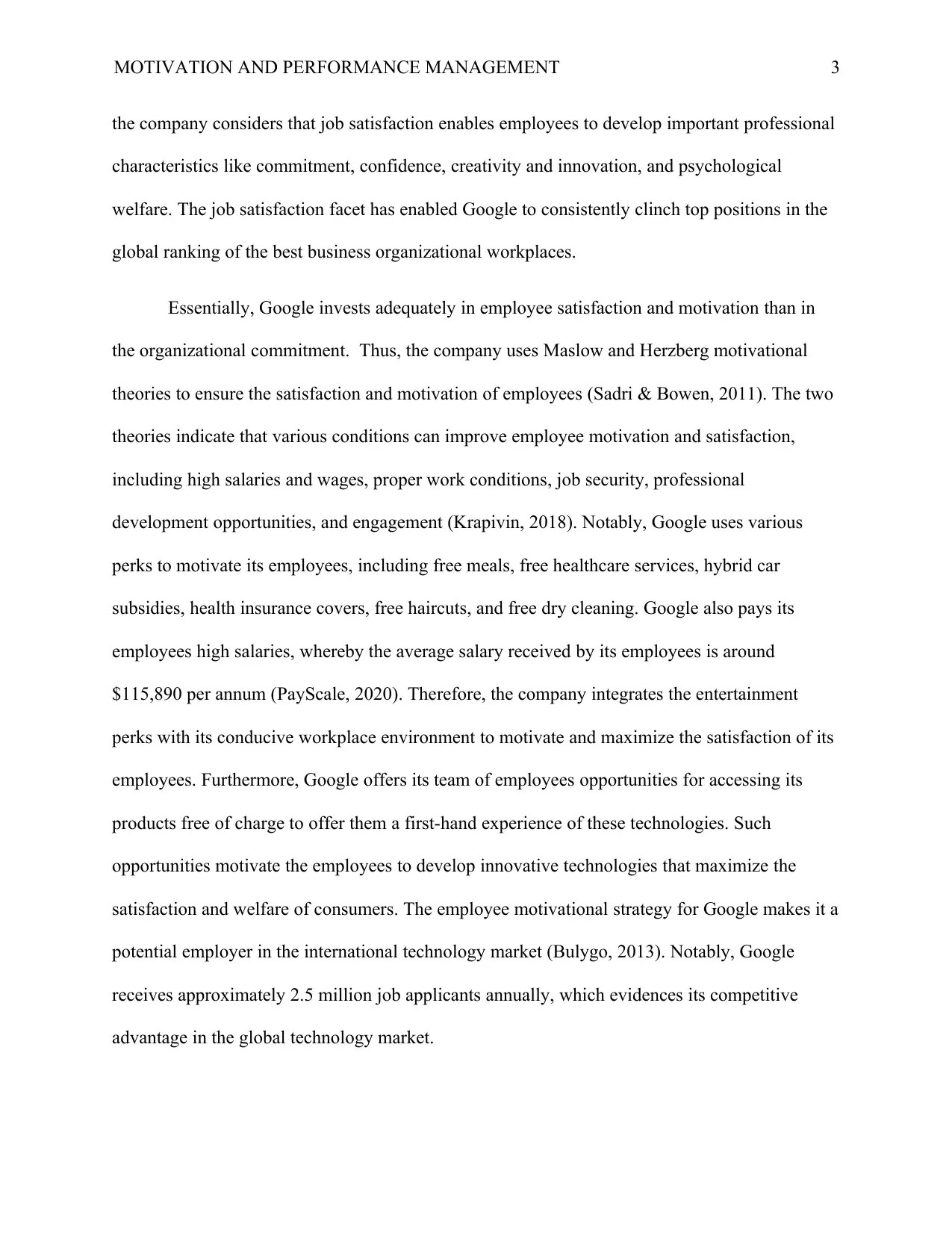
MOTIVATION AND PERFORMANCE MANAGEMENT 3
the company considers that job satisfaction enables employees to develop important professional
characteristics like commitment, confidence, creativity and innovation, and psychological
welfare. The job satisfaction facet has enabled Google to consistently clinch top positions in the
global ranking of the best business organizational workplaces.
Essentially, Google invests adequately in employee satisfaction and motivation than in
the organizational commitment. Thus, the company uses Maslow and Herzberg motivational
theories to ensure the satisfaction and motivation of employees (Sadri & Bowen, 2011). The two
theories indicate that various conditions can improve employee motivation and satisfaction,
including high salaries and wages, proper work conditions, job security, professional
development opportunities, and engagement (Krapivin, 2018). Notably, Google uses various
perks to motivate its employees, including free meals, free healthcare services, hybrid car
subsidies, health insurance covers, free haircuts, and free dry cleaning. Google also pays its
employees high salaries, whereby the average salary received by its employees is around
$115,890 per annum (PayScale, 2020). Therefore, the company integrates the entertainment
perks with its conducive workplace environment to motivate and maximize the satisfaction of its
employees. Furthermore, Google offers its team of employees opportunities for accessing its
products free of charge to offer them a first-hand experience of these technologies. Such
opportunities motivate the employees to develop innovative technologies that maximize the
satisfaction and welfare of consumers. The employee motivational strategy for Google makes it a
potential employer in the international technology market (Bulygo, 2013). Notably, Google
receives approximately 2.5 million job applicants annually, which evidences its competitive
advantage in the global technology market.
the company considers that job satisfaction enables employees to develop important professional
characteristics like commitment, confidence, creativity and innovation, and psychological
welfare. The job satisfaction facet has enabled Google to consistently clinch top positions in the
global ranking of the best business organizational workplaces.
Essentially, Google invests adequately in employee satisfaction and motivation than in
the organizational commitment. Thus, the company uses Maslow and Herzberg motivational
theories to ensure the satisfaction and motivation of employees (Sadri & Bowen, 2011). The two
theories indicate that various conditions can improve employee motivation and satisfaction,
including high salaries and wages, proper work conditions, job security, professional
development opportunities, and engagement (Krapivin, 2018). Notably, Google uses various
perks to motivate its employees, including free meals, free healthcare services, hybrid car
subsidies, health insurance covers, free haircuts, and free dry cleaning. Google also pays its
employees high salaries, whereby the average salary received by its employees is around
$115,890 per annum (PayScale, 2020). Therefore, the company integrates the entertainment
perks with its conducive workplace environment to motivate and maximize the satisfaction of its
employees. Furthermore, Google offers its team of employees opportunities for accessing its
products free of charge to offer them a first-hand experience of these technologies. Such
opportunities motivate the employees to develop innovative technologies that maximize the
satisfaction and welfare of consumers. The employee motivational strategy for Google makes it a
potential employer in the international technology market (Bulygo, 2013). Notably, Google
receives approximately 2.5 million job applicants annually, which evidences its competitive
advantage in the global technology market.
⊘ This is a preview!⊘
Do you want full access?
Subscribe today to unlock all pages.

Trusted by 1+ million students worldwide
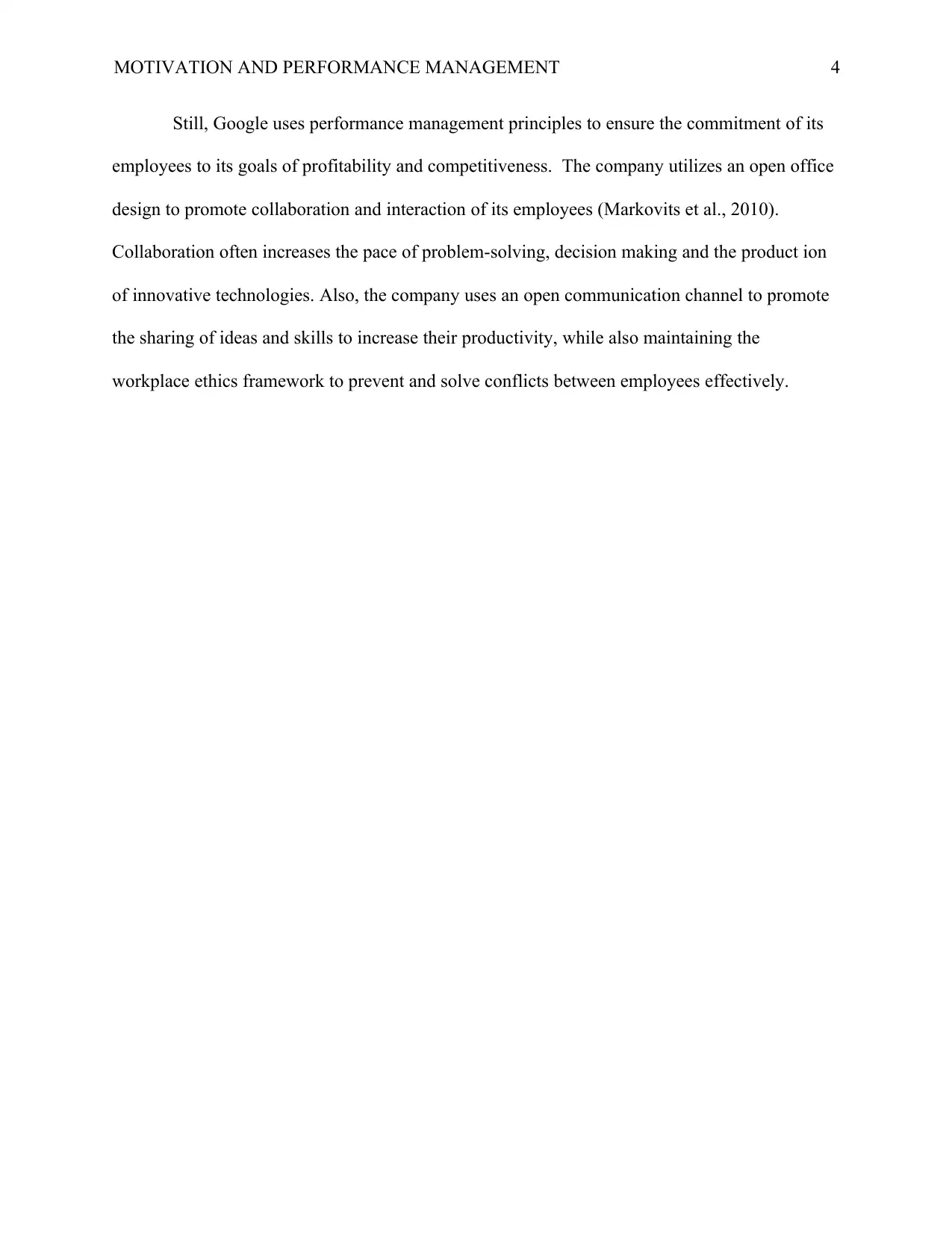
MOTIVATION AND PERFORMANCE MANAGEMENT 4
Still, Google uses performance management principles to ensure the commitment of its
employees to its goals of profitability and competitiveness. The company utilizes an open office
design to promote collaboration and interaction of its employees (Markovits et al., 2010).
Collaboration often increases the pace of problem-solving, decision making and the product ion
of innovative technologies. Also, the company uses an open communication channel to promote
the sharing of ideas and skills to increase their productivity, while also maintaining the
workplace ethics framework to prevent and solve conflicts between employees effectively.
Still, Google uses performance management principles to ensure the commitment of its
employees to its goals of profitability and competitiveness. The company utilizes an open office
design to promote collaboration and interaction of its employees (Markovits et al., 2010).
Collaboration often increases the pace of problem-solving, decision making and the product ion
of innovative technologies. Also, the company uses an open communication channel to promote
the sharing of ideas and skills to increase their productivity, while also maintaining the
workplace ethics framework to prevent and solve conflicts between employees effectively.
Paraphrase This Document
Need a fresh take? Get an instant paraphrase of this document with our AI Paraphraser
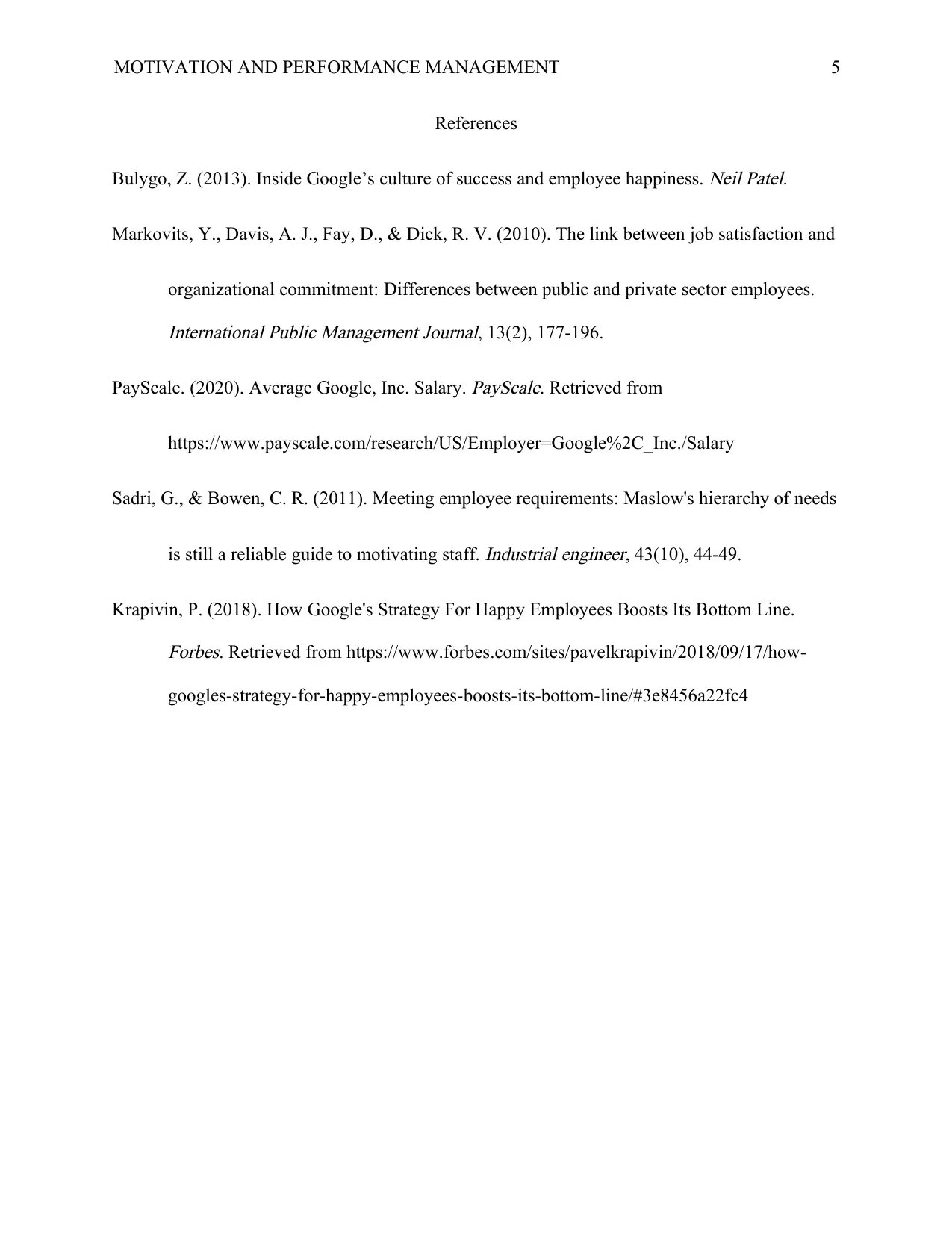
MOTIVATION AND PERFORMANCE MANAGEMENT 5
References
Bulygo, Z. (2013). Inside Google’s culture of success and employee happiness.
Neil Patel.
Markovits, Y., Davis, A. J., Fay, D., & Dick, R. V. (2010). The link between job satisfaction and
organizational commitment: Differences between public and private sector employees.International Public Management Journal, 13(2), 177-196.
PayScale. (2020). Average Google, Inc. Salary.
PayScale. Retrieved from
https://www.payscale.com/research/US/Employer=Google%2C_Inc./Salary
Sadri, G., & Bowen, C. R. (2011). Meeting employee requirements: Maslow's hierarchy of needs
is still a reliable guide to motivating staff.
Industrial engineer, 43(10), 44-49.
Krapivin, P. (2018). How Google's Strategy For Happy Employees Boosts Its Bottom Line.Forbes. Retrieved from https://www.forbes.com/sites/pavelkrapivin/2018/09/17/how-
googles-strategy-for-happy-employees-boosts-its-bottom-line/#3e8456a22fc4
References
Bulygo, Z. (2013). Inside Google’s culture of success and employee happiness.
Neil Patel.
Markovits, Y., Davis, A. J., Fay, D., & Dick, R. V. (2010). The link between job satisfaction and
organizational commitment: Differences between public and private sector employees.International Public Management Journal, 13(2), 177-196.
PayScale. (2020). Average Google, Inc. Salary.
PayScale. Retrieved from
https://www.payscale.com/research/US/Employer=Google%2C_Inc./Salary
Sadri, G., & Bowen, C. R. (2011). Meeting employee requirements: Maslow's hierarchy of needs
is still a reliable guide to motivating staff.
Industrial engineer, 43(10), 44-49.
Krapivin, P. (2018). How Google's Strategy For Happy Employees Boosts Its Bottom Line.Forbes. Retrieved from https://www.forbes.com/sites/pavelkrapivin/2018/09/17/how-
googles-strategy-for-happy-employees-boosts-its-bottom-line/#3e8456a22fc4
1 out of 5
Related Documents
Your All-in-One AI-Powered Toolkit for Academic Success.
+13062052269
info@desklib.com
Available 24*7 on WhatsApp / Email
![[object Object]](/_next/static/media/star-bottom.7253800d.svg)
Unlock your academic potential
Copyright © 2020–2025 A2Z Services. All Rights Reserved. Developed and managed by ZUCOL.




